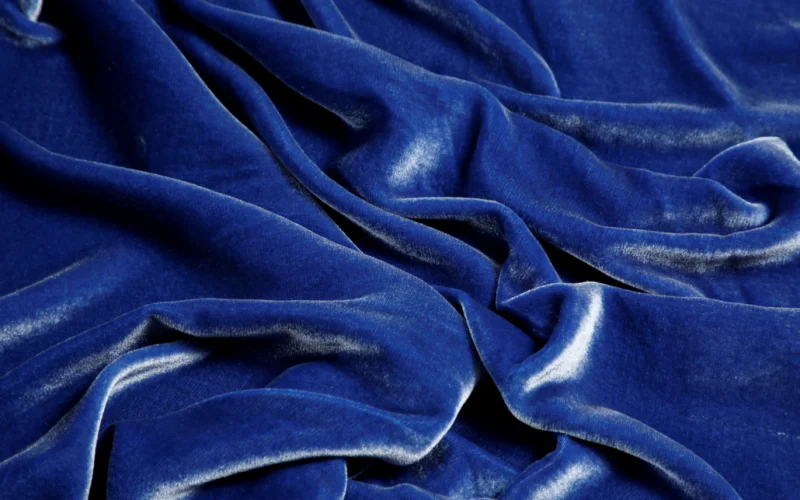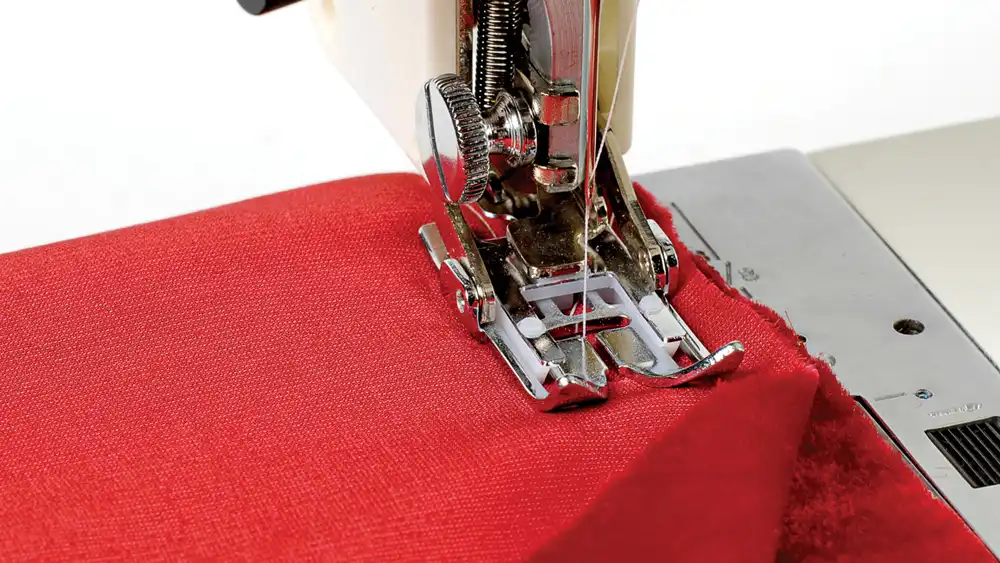Sewing with velvet can seem intimidating, but it doesn’t have to be! In this comprehensive guide on how to sew velvet fabric, we’ll break down everything you need to know. Velvet has a unique texture that adds a luxurious touch to any project, but it requires a few special techniques to handle it properly.
From choosing the right tools to mastering your sewing techniques, we’ll help you create stunning pieces with ease. Let’s dive into the world of velvet sewing and unleash your creativity!
What Is Velvet Fabric?

Velvet fabric is a soft, luxurious material known for its rich texture and sheen. It typically features a short pile, which gives it a unique feel and appearance. Velvet can be made from various fibers, including silk, cotton, and polyester. It’s perfect for making elegant garments, cushions, and drapes.
If you’re wondering how to sew velvet fabric, remember that it requires special handling due to its tendency to shift. With the right techniques, you can create stunning pieces that showcase the beauty of this fabric!
Types Of Velvet Fabric
The first step in sewing with velvet is to choose the right fabric for your project. Velvet comes in a variety of fibers, including silk, cotton, polyester, and a blend of these materials. Each type of velvet has its own unique properties and characteristics, so it’s important to consider the specific requirements of your project when making your selection.
Silk Velvet

Silk velvet is considered the most luxurious and high-quality type of velvet. It is characterized by a soft, lustrous sheen and a smooth, velvety texture. Silk velvet is often used in high-end fashion, upholstery, and home decor applications, but it can be more expensive and delicate to work with compared to other velvet varieties.
Cotton Velvet
Cotton velvet is a more affordable and durable option that is often used for everyday clothing and home furnishings. It has a slightly rougher texture and a more matte appearance compared to silk velvet, but it is generally easier to sew and maintain.
Polyester Velvet
Polyester velvet is a synthetic alternative that is known for its durability, easy care, and affordability. It is often used in budget-friendly projects, such as costumes and home accents, but it may not have the same luxurious feel as natural fiber velvets.
In addition to the fiber content, you should also consider the weight and pile height of the velvet fabric. Heavier, higher-pile velvets may be more challenging to work with, as they can be more prone to shifting and snagging. Lighter, lower-pile velvets, on the other hand, may be easier to handle but may not have the same plush, velvety appearance.
How To Sew Velvet Fabric?

STEP1 How To Sew Velvet Fabric:Select the Right Velvet Fabric
Choosing the right velvet fabric is crucial for your project. Look for options based on the weight and texture that suit your needs. Lighter velvets work well for garments, while heavier ones are great for upholstery.
Consider the fiber content too—silk velvet has a luxurious feel, while cotton velvet is more durable. Think about the color and pattern that will complement your design. A well-chosen velvet will make all the difference in your final piece!
STEP2 How To Sew Velvet Fabric:Prewash and Dry the Fabric
Before diving into your sewing project, prewash and dry your velvet fabric. This step removes any chemicals and ensures your fabric is clean and ready to work with. Use cold water and a gentle cycle to prevent any damage. Once washed, dry the fabric on low heat. Prewashing also helps to minimize any future shrinkage, allowing your finished product to maintain its shape and size.
STEP3 How To Sew Velvet Fabric:Iron Velvet Carefully

Ironing velvet requires a delicate touch. Use a low heat setting on your iron to avoid damaging the fabric. Always place a pressing cloth between the iron and the velvet to protect it. Press the fabric gently without dragging the iron, as this can crush the pile.
If your velvet has deep wrinkles, try steaming instead. Properly ironing your fabric sets the stage for a smooth sewing experience and enhances the final look of your project.
STEP4 How To Sew Velvet Fabric:Cut the Fabric Precisely
When cutting velvet, precision is key. Lay the fabric flat on a cutting mat, ensuring it’s wrinkle-free. Use sharp scissors or a rotary cutter for clean edges. Always cut in one direction to avoid fraying the pile. If your pattern includes nap, make sure all pieces align in the same direction. Take your time with this step; accurate cutting will make a big difference in how your project turns out.
STEP5 How To Sew Velvet Fabric:Stabilize the Fabric
Velvet can shift easily while sewing, so stabilizing it is essential. Use a lightweight fusible interfacing on the back of the fabric pieces to provide extra support. This technique helps keep the fabric from stretching and ensures your seams stay neat. Alternatively, you can use fabric weights or clips instead of pins to hold the pieces in place without leaving marks. A stable foundation leads to a more polished final product.
STEP6 How To Sew Velvet Fabric:Mark Patterns/Lines Carefully
Marking your patterns and sewing lines, use a fabric chalk or a water-soluble pen. Avoid traditional pens or pencils, as they can leave permanent marks. Carefully transfer all markings from your pattern onto the fabric, ensuring accuracy. Take your time here, as these marks guide your sewing. Properly marked lines lead to a more professional finish, making your project look polished and well-made.
STEP7 How To Sew Velvet Fabric: Use the Right Needle and Thread
Selecting the right needle and thread is vital for sewing velvet. Use a universal or ballpoint needle, which helps glide through the fabric without snagging. Choose a high-quality thread that matches your fabric—polyester works well for most projects. If you’re working with heavier velvet, consider a thicker needle to accommodate the fabric’s weight. This choice ensures smooth sewing and prevents unwanted damage.
STEP8 How To Sew Velvet Fabric: Adjust Stitch Length
Before you start sewing, adjust your stitch length for velvet. A longer stitch (around 3.5 to 4mm) helps prevent the fabric from bunching or puckering. Test your settings on a scrap piece of velvet first to ensure you achieve the desired look. A well-adjusted stitch length leads to even seams and a polished appearance, making your sewing experience much smoother.
STEP9 How To Sew Velvet Fabric: Baste First
Basting is a helpful step when working with velvet. Use a long, loose stitch to hold your fabric pieces together temporarily. This method keeps the fabric in place and allows you to check the fit before sewing the final seams. Basting prevents shifting and ensures your seams line up perfectly. Don’t skip this step; it saves you time and frustration later in the sewing process.
STEP10 How To Sew Velvet Fabric: Utilize Specialty Presser Feet
Using specialty presser feet can make sewing velvet easier and more efficient. A walking foot helps move multiple layers of fabric evenly, reducing the risk of shifting. A teflon foot is another great option, as it glides smoothly over the fabric’s surface. Investing in the right presser foot will make your sewing experience more enjoyable and improve the quality of your finished project.
STEP11 How To Sew Velvet Fabric: Press Seams Carefully
After sewing, press your seams with care. Use a low heat setting and a pressing cloth to protect the velvet. Gently open the seams and press them flat, being cautious not to crush the pile. If your project includes curved seams, consider using a seam roll for more precision. Properly pressed seams give your project a professional finish and enhance the overall appearance.
STEP12 How To Sew Velvet Fabric: Clip Curves and Corners
Clipping curves and corners is essential for achieving smooth edges. Carefully snip into the seam allowance without cutting through your stitches. This technique helps the fabric lay flat when turned right side out. For rounded corners, trim excess fabric to reduce bulk. Take your time with this step to ensure clean, crisp lines in your finished project.
STEP13 How To Sew Velvet Fabric: Finish Edges Neatly
Finishing the edges of your velvet fabric prevents fraying and gives a polished look. You can use a serger for clean edges or zigzag stitch along the seam allowances. Another option is to use bias tape to encase the edges, adding a decorative touch. Neat finishing helps maintain the integrity of your fabric and enhances the durability of your project.
STEP14 How To Sew Velvet Fabric: Hem Carefully
Hemming velvet requires a gentle approach. Fold the hem to the desired length and pin it in place. Use a blind hem stitch or a straight stitch for a clean finish. Always press the hem before sewing to ensure it lays flat. Take your time with this step, as a well-done hem elevates your project and showcases the beauty of the velvet.
STEP15 How To Sew Velvet Fabric: Apply Finishing Touches
Finally, apply those finishing touches to complete your project. Give it a final press, ensuring everything looks neat. Consider adding embellishments like trims or buttons to enhance the design. Check for any loose threads and snip them away.
Conclusion
Sewing with velvet can be a delightful experience. This luxurious fabric adds elegance to any project. However, working with velvet requires special techniques to achieve the best results. In this guide, we will explore how to sew velvet fabric successfully.
You will learn essential tips for cutting, sewing, and finishing your projects. Whether you’re making garments, home decor, or accessories, mastering velvet sewing will elevate your creations. Let’s dive into the wonderful world of velvet and unleash your creativity!
FAQ
How to sew stretch velvet fabric?
To sew stretch velvet fabric, use a ballpoint needle to avoid snagging the fibers. Choose a stretch or zigzag stitch to allow for fabric movement. Always prewash the fabric to prevent shrinkage. Use a walking foot to keep layers from shifting, and pin carefully to maintain alignment. Baste the seams first to check fit before final stitching. This approach helps create a smooth finish and ensures your project has the right amount of stretch.
How to sew velvet upholstery fabric?
Sewing velvet upholstery fabric, start with a sharp, heavy-duty needle to handle the thickness. Use a walking foot for even feeding of the fabric layers. Prewash the fabric if necessary, and cut it carefully to avoid fraying. Pin or clip edges securely to prevent shifting. Use a long stitch length for durability and to reduce puckering. Press seams gently with a low heat setting to maintain the fabric’s texture and appearance.
How to sew a velvet fabric dress?
To sew a velvet fabric dress, begin by choosing a simple pattern to ease the process. Use a ballpoint needle and a stretchy thread for best results. Prewash the fabric to remove any chemicals. Cut the fabric carefully, ensuring the nap runs in one direction. Pin the pieces together, and baste seams to check the fit. Use a longer stitch length and press seams lightly to avoid crushing the pile. Finish with a neat hem to complete your dress.
